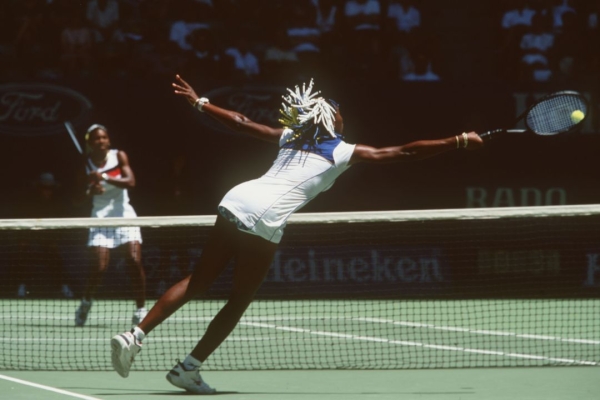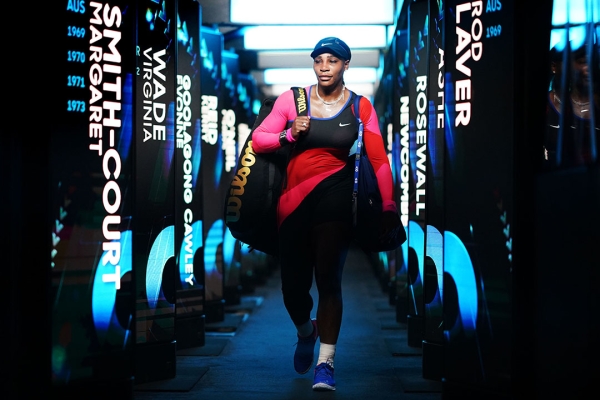Rarely has the tennis world witnessed Serena Williams standing still.
But there she was, one hand clasped over her heart and the other raised into the air, stopping just shy of the Rod Laver Arena court exit and saluting the Australian crowd – turning, waving – and taking it in.
For what turned out to be one last time.
“If I ever say farewell, I wouldn't tell anyone,” Williams said after losing to eventual champion Naomi Osaka in the Australian Open 2021 semifinals, before tearing up a few minutes later and ending her press conference.
Some 18 months later, Williams is – indeed – saying farewell to the sport of tennis. She announced as much in a revealingly personal essay for Vogue, written in a winding, reflective and outwardly Serena sort of way. She’s not retiring; she’s “evolving away from tennis.”
That part of her journey ended at the US Open on Friday night, with her three-set loss to Ajla Tomljanovic in the third round, a compelling, dramatic final act lasting more than three hours in front of a sold-out Arthur Ashe Stadium crowd.
She’s onto the next – always on the move.
Much like her Melbourne exit on that February day, it’s always been Serena’s way. From before she first took her first steps onto Rod Laver Arena in 1998 as a 16-year-old to face big sister Venus, to Australian Open 2003, when she completed her first of two “Serena Slams.” And to her record-setting (and ultimately final) major title win at AO 2017, a final fittingly played against Venus.
AO FLASHBACK: Williams double act lights up AO 2017 final
SERENA'S LEGACY: Australian tennis stars reflect
Serena was moving forward that evening five years ago, too; she was eight weeks pregnant with daughter Olympia. Her legacy was far and away sealed, but she was only adding to her glory, following a childhood that began on the courts of Compton, California; the first signs of a once-in-a-generation prowess that touched every curve of the globe.
From the corner of Melbourne's Collins and Swanston streets, to London's SW19 and the Champs-Élysées in Paris, to New York’s Madison Avenue.
She became just Serena. And only she built that reputation and recognition.
Serena Down Under – from every angle
As Serena bids farewell just before her 41st birthday, the Australian Open serves as a benchmark event for her career at nearly every juncture, though she won just (just!) seven of her Open Era-record 23 singles majors at Melbourne Park.
The first is perhaps the most iconic; the completion of the “Serena Slam” in 2003, which came after she won Roland Garros, Wimbledon and the US Open in 2002.
No player had achieved the calendar Grand Slam since Steffi Graf in 1988, but Serena’s way was hers: Four consecutive majors. Who cared if it happened to be in a calendar year?
“Whether it was in one year or not... I think anyone would want to say that they [had won the Grand Slam] if they won four in a row,” Serena said that night in 2003, after beating Venus 7-6(4) 3-6 6-4 in one of their closest-ever encounters.
Four years later, Serena was back. She was ranked No.81 and had barely played in two years since her 2005 triumph in Melbourne, which included one of the most iconic come-from-behind wins in her career, a 2-6 7-5 8-6 victory over then-rival but soon-to-become tennis play toy, Maria Sharapova.
The year was 2007 and the headlines were blaring: Serena was “out of shape” and in no contention to win the AO. Nike was even threatening to pull their contract with the 25-year-old.
Yet she would drop just two sets in seven matches played, a 6-1 6-2 drubbing of Sharapova in the final one of her all-time sublime performances.
It was a clear warning sign from Serena, a theme that would play out time and again: Doubt me and I’ll prove you wrong – and that’s a promise.
"To me that’s kind of the essence of being Serena: expecting the best from myself and proving people wrong. There were so many matches I won because something made me angry or someone counted me out," she wrote in Vogue.
"That drove me. I’ve built a career on channeling anger and negativity and turning it into something good."

The New York Times called it “one of the most remarkable comebacks in tennis history” and indeed it was, but it also was more foreshadowing of what was to come for Serena: 16 more majors over the next decade – including her AO 2015 win, also over Sharapova, which served as the second leg of her second “Serena Slam”.
It very nearly became the first calendar Slam since Graf some 27 years prior, stopped only two matches shy in the US Open semifinals.
Serena: ‘Something for the future’
If you watch highlights of that very first meeting with Venus at the AO in 1998, Serena’s major debut, there is one – well, two – things that are striking.
First, the beads. (Bring back the beads!) But secondly, it’s the sound: Tennis had never popped like this.
The Williams sisters changed the game with their ball striking. Open stance, athletic, deep and powerful. Steffi Graf, Monica Seles, Mary Pierce, Lindsay Davenport and more had ushered in an era of what commentator Mary Carillo described as “Big Babe” tennis, but Venus and Serena took the “big” and made it... gigantic.
And then took over the tennis world.

“What you saw was something for the future,” Serena remarked, prophetically, following that 1998 second-round encounter, won by Venus 7-6(4) 6-1.
This coming January will mark 25 years since that match, perhaps two professional tennis lifetimes in measurement, but only one for Serena. There are no more beads, no more battles with her big sister.
There is only memories and a career that could go unmatched for generations to come.
"There's so many things to be remembered by," Serena reflected after her US Open campaign, and career, came to an end this week.
"Like the fight. I'm such a fighter. I feel like I really brought something, and bring something, to tennis. The different looks, the fist pumps, the just crazy intensity. I think that obviously the passion I think is a really good word. Just continuing through ups and downs.
"I could go on and on. But I just honestly am so grateful that I had this moment and that I'm Serena."
How does an icon truly say farewell? Especially in a time where things move so fast in our world?
They stop, but only for just a second, hand over their hearts – and wave.
And we wave back. Thankful for what we witnessed and wondering if it was all a dream. Twenty-three majors, 319 weeks at world No. 1, four Olympic gold medals and some 850 match wins later.
And when you realise the moment has passed, the icon is already in the exit tunnel, making moves for what comes next. Walking through the darkness and into a light that only she can see. Just the way she’s always done it.
Serena’s way.
